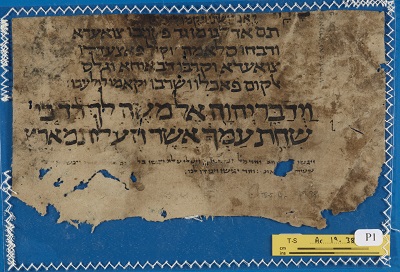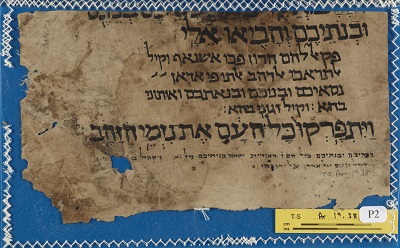Two fragments (T-S AS 72.79 and T-S Ar.1a.38) of Saadiah’s tafsīr by Samuel ben Jacob
T-S AS 72.79 and T-S Ar.1a.38 contain the text of Saadiah Gaon’s translation (tafsīr) on Exodus 32:2 and 25:3-5. The tafsīr constitutes the main Judaeo-Arabic translation tradition in the Genizah corpus and so ‘another two fragments’ are admittedly not a great source of astonishment. And yet, despite the fact that the text is so frequently found, the two leaves caught my eye immediately: they are virtually identical to the recently discovered manuscript St Petersburg RNL Yevr. II C 1, which contains the earliest known copy of the complete Pentateuch translation of Saadiah. This copy was completed about sixty years after the demise of the Gaon and it preserves his translation in the most precise and accurate way, both in wording and language.
The two Genizah fragments originate without any doubt from the same hand. They are identical, but only cover the book of Exodus, apparently attesting that the scribe produced a separate copy of that book for an unknown purchaser. The Hebrew text is presented in large, calligraphic, oriental square letters with full Tiberian vocalisation; beneath it, Saadiah’s translation is found in smaller semi-cursive letters. The St Petersburg manuscript embraces 720 folio pages; nevertheless, rather large parts are missing. It was copied by Samuel ben Jacob, who is known as an expert producer of Masoretic model codices. Likewise the magnificent Leningrad Codex (RNL Yevr. B 19a) was written and vocalized by him in the year 1008–9 CE in Fusṭāṭ. Although no date is given in the former manuscript it may be assumed that it was copied around the same time as the latter.
MS St Petersburg RNL Yevr. II C 1 opens with an ownership note, which is repeated at the beginning of every book, stating that this codex was commissioned by Solomon ben Abraham. Two Genizah fragments indicate that he was involved in trading with the Levantine coast, particularly with Tyre. His engagement in commerce and his consequent prestigious status — as indicated by the honorary title ha-Paqid in the manuscript — permitted him to commission such a splendid codex. A second ownership note leads directly to Tyre, for it appears that Solomon ha-Kohen, brother of—and Av Bet Din under— Gaon Evyatar (Abiathar) ha-Kohen, acquired the codex. Under his father Elijah ha-Kohen Gaon the Palestinian academy moved to Tyre as a result of the Turcoman conquest of Palestine. The date of purchase is given as 1084, thus the transfer of ownership must have taken place immediately after the appointment of Evyatar ha-Kohen as Gaon.
The Genizah fragments and the St Petersburg manuscript resemble each other in another feature. Foreign to Saadiah’s practice — and even antipodal to his own concept of scriptural translation — they exhibit innumerable alternative renderings, which are introduced by the Arabic terms wa-qīl or wa-yuqāl. It is noteworthy that they only occur in the book of Exodus, mainly after Parashat Mishpatim, where they are at times found in every verse, or even twice in one verse.
Hitherto, alternative renderings were considered an exclusive and distinctive hallmark of the pre-Saadianic and Karaite translation traditions. The total absence of that feature in the bulk of the Genizah material, as well in later manuscripts, allows no other assumption than that the alternative renderings were introduced as a kind of internal gloss by the scribe Samuel ben Jacob himself (as already pointed out by H. Ben-Shammai 2000). The additional Genizah fragments stemming from his hand, in which they are incorporated in the very same manner, prove this. Internal evidence may also be found in the translation of Exodus 29:9. In the first half of the verse,ואשדדהם וקיל בזנאניר, the copyist apparently forgot to enter the gloss. In the second half, פתציר להם פתכון, he mistakenly omitted וקיל, which was consequently added over the line. Both instances suggest that the glosses were appended in the actual course of copying.
Certain tendencies may be detected: the glosses typically occur when Saadiah’s translation is difficult for the reader to comprehend. On those occasions when the Gaon commits himself to translate the Hebrew into idiosyncratic, high-standard Classical Arabic, an alternative rendering in Middle Arabic is frequently found. Equally, highly synthetic translations are annotated by an explanatory gloss. Further, a need was felt to append a gloss to Saadiah’s usages of homophonous cognates in Arabic.
A close scrutiny of later manuscripts — whether of early oriental or relatively late Yemenite provenance — reveals, however, that these also occasionally feature readings akin to the glosses of MS St Petersburg RNL Yevr. II C 1. This fact evokes the crucial question: on which traditions did Samuel ben Jacob rely? Could it be that the glosses in fact draw upon genuine Saadianic material that resurfaced in the margins of the standardised transmission of the short tafsīr? Considering the Genizah fragments’ readings at Exodus 23:1 and 29:20, this might very likely be the case. In one of the fragments of his commentary on Exodus (published by Y. Raztaby 1998), Saadiah informs us of his difficulties in translating the Hebrew אל תשת ידך עם רשע להיות עד חמס. He proposes two options in Arabic, similar to the two variants of the St Petersburg manuscript. One is given as the standard translation, the other, as an alternative rendering that goes on to re-occur in the Yemenite tradition. In Exodus 29:20 the Hebrew term הרון תנוך אזן is translated שחמה אד'ן הרון, yet it appears as גצ'רוף אד'ן הרון in the gloss, as documented in Saadiah’s commentary and the Yemenite tradition.
In summary, it stands to reason that the glosses were introduced by the scribe Samuel ben Jacob by incorporating material of Saadiah’s commentary on Exodus. The additional Genizah fragments stemming from his hand, into which that material is interwoven in the very same manner, prove this. The glosses, thus, have to be seen in the light of intentional scribal editorial activity.
The first piece of T-S Ar.1a.38 (recto)
The second piece of T-S Ar.1a.38 (recto)
Readers are invited to send comments to genizah@lib.cam.ac.uk. The Taylor-Schechter Genizah Research Unit is not under any obligation to acknowledge or to publish comments.
Bibliography
J. Blau, ‘Saadya Gaon's Pentateuch translation in the Light of an Early-Eleventh-Century Egyptian Manuscript’, Leshonenu 61 (1998), pp. 111–130
R. Gottheil, ‘Some Hebrew Manuscripts in Cairo’, JQR 17 (1905), pp. 609–655 ; no. 27, pp. 636–7
Sh. D. Goitein, A Mediterranean Society, Berkeley 1967–93, vol. I, p. 362
E. Bareket, The Jews of Egypt 1007–1055, Jerusalem 1995, Document no. 88, pp. 155–57
J. Mann, The Jews in Egypt and in Palestine under the Fatimid caliphs, Oxford 1969, pp. 178–201
J. Mann, Texts and Studies, Cincinnati 1931–35, Vol. 1, pp. 249–51
Harkavy/Strack's, Catalog der hebräischen Bibelhandschriften der Kaiserlichen-öffentlichen Bibliothek in St. Petersburg, St Petersburg 1875, pp. 269ff
M. Polliack, The Karaite tradition of Arabic Bible translation, Leiden 1997, pp. 181–200
M. Polliack, ‘Alternative renderings and additions in the Yeshuah ben Yehudah's translation of the Pentateuch’, JQR 84 (1993-94), pp. 209–224
H. Ben-Shammai, ‘New and Old: Saadya's Two Introductions to his Translations of the Pentateuch’, Tarbiz 69 (2000), pp. 199–210
H. Ben-Shammai, Yefet ben ‘Eli al-Baṣri, Commentary on Genesis, Jerusalem 2000, pp. 181-206 (esp. pp. 197–199)
Y. Ratzaby, Rav Saadya's Commentary on Exodus, Jerusalem 1998
Cite this article
(2009). Two fragments (T-S AS 72.79 and T-S Ar.1a.38) of Saadiah’s tafsīr by Samuel ben Jacob. [Genizah Research Unit, Fragment of the Month, November 2009]. https://doi.org/10.17863/CAM.55275
If you enjoyed this Fragment of the Month, you can find others here.
Contact us: genizah@lib.cam.ac.uk
The zoomable images are produced using Cloud Zoom, a jQueryimage zoom plugin:
Cloud Zoom, Copyright (c) 2010, R Cecco, www.professorcloud.com
Licensed under the MIT License


